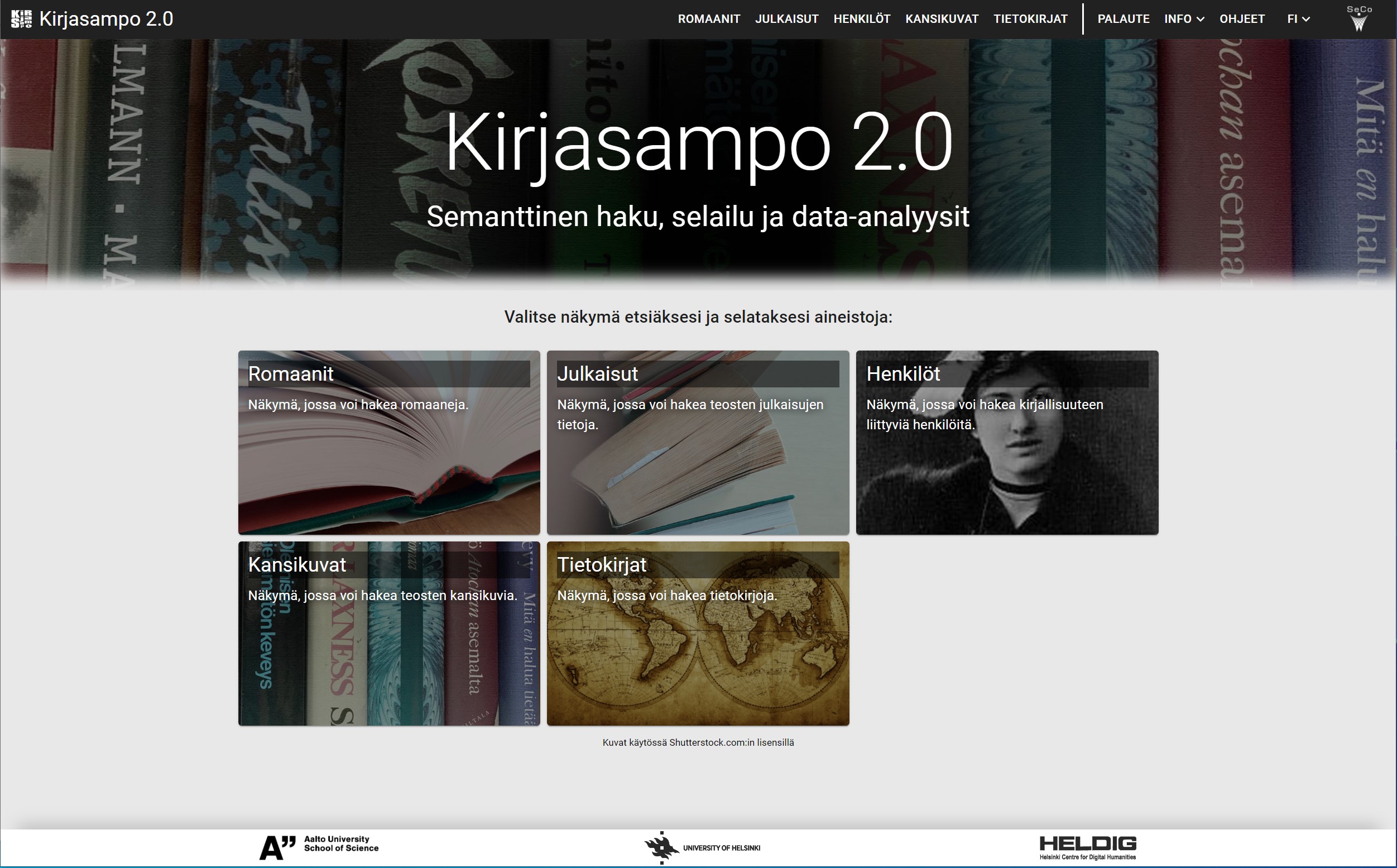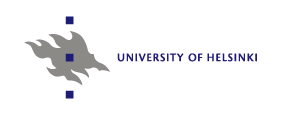Tervetuloa julkistustilaisuuteen Aalto-yliopistossa ja online:
Kirjasampo 2.0 – semanttinen haku, selailu ja data-analyysit
Suomalaisen kirjallisuuden päivänä, tiistaina 10.10.2023, klo 13:00–15:00
Aalto-yliopisto, TUAS-talo, sali AS2, Maarintie 8, Otaniemi
Semanttisen laskennan tutkimusryhmä (SeCo), Aalto-yliopiston tietotekniikan laitos, Helsingin yliopiston Digitaalisten ihmistieteiden keskus HELDIG ja yleisten kirjastojen Kirjastot.fi-verkkopalvelut kutsuvat Teidät avoimeen ja maksuttomaan tilaisuuteen, jossa julkistetaan prototyyppi Kirjasampo-palvelun uudesta semanttisesta käyttöliittymästä Kirjasampo 2.0 sekä sen perustana olevasta linkitetyn avoimen datan palvelusta. Kirjasampo 2.0 tarjoaa uuden vaihtoehtoisen tavan hakea ja tutkia suomalaista kirjallisuutta digitaalisten ihmistieteiden menetelmin täydentäen nykyistä Kirjasampo.fi:n käyttöliittymää.

Kirjasampo 2.0:n etusivu ja viisi sovellusnäkymää
Mikä on Kirjasampo 2.0?
Kirjasampo on yleisten kirjastojen tarjoama tietopalvelu, joka julkaisee rikasta linkitettyä tietoa lähes kaikesta Suomessa julkaistusta kaunokirjallisuudesta ja kirjailijoista. Nykyään aineistoon kuuluu myös mm. tietokirjoja. Järjestelmällä on vuosittain n. 1,6 miljoonaa käyttäjää, ja se on osa yleisten kirjastojen valtakunnallisia verkkopalveluita Kirjastot.fi. Järjestelmän semanttisen webin teknologioihin perustuva prototyyppi kehitettiin Aalto-yliopistossa ja Helsingin yliopistossa osana kansallista FinnONTO-hankesarjaa 2003–2012 ja se otettiin julkiseen käyttöön vuonna 2011 yleisten kirjastojen toimesta.
Kirjasampo kuuluu laajempaan Sampo-datapalveluiden ja -portaalien sarjaan.
Kirjasammon nykyinen käyttöliittymä toteutettiin perinteisin menetelmin Kirjastot.fi-organisaation toimesta eikä se ole nykyisen Sampo-mallin mukainen, mikä mahdollistaisi aineistojen semanttisen haun, selailun, data-analyysit ja visualisoinnit. Nykyisen käyttöliittymän rikastamiseksi uusilla ominaisuuksilla suunniteltiin Aalto-yliopistossa yhteistyössä yleisten kirjastojen kanssa uusi, Sampo-mallin mukainen käyttöliittymän prototyyppi,
Kirjasampo 2.0 – semanttinen haku, selailu ja data-analyysit kirjallisuuden tutkimiseen, joka toteutettiin
Sampo-UI-työkalun avulla. Kirjasammon taustalla olevaa tutkimustyötä on esitelty tarkemmin hankkeen
kotisivulla, jolta löytyy myös aiheeseen liittyviä artikkeleita.
Kirjasampo on tarkoitus liittää osaksi Suomen Akatemian rahoittamaa kansallista FIN-CLARIAH-tutkimusinfrastruktuuria.
Datapalvelu ja portaali verkossa
Kirjasampo-data julkaistaan verkossa toiminnallisena SPARQL-rajapintana Linked Data Finland -alustalla (LDF.fi):
https://www.ldf.fi/dataset/kirjasampo
Kirjasampo 2.0 -portaali, joka perustuu em. SPARQL-rajapintapalveluun, avataan osoitteessa:
https://analyysi.kirjasampo.fi
Lisätietoa Kirjasammosta
Alustava ohjelma
Tilaisuus alkaa Kirjasampo 2.0 -hankkeen vetäjän prof. Eero Hyvösen esitelmällä. Tämän jälkeen kuullaan yleisten kirjastojen edustajien Matti Sarmelan, Kaisa Hypénin ja Tuomas Aitonurmen puheenvuorot. Sitten projektiryhmän väitöskirjatutkija Heikki Rantala kertoo uuden käyttöliittymän toteutuksessa käytetystä Sampo-UI-työkalusta ja DI Annastiina Ahola esittelee, miten Kirjasampo 2.0:n datapalvelu ja semanttinen portaali luotiin ja miten tätä käytetään. Lopuksi FM Telma Peura esittelee datapalvelun avulla tehtyä kirjallisuuden tutkimusta.
- 13:00–13:15 Miksi Kirjasampo 2.0 taottiin: Sampo-mallin esittely
Eero Hyvönen, professori, Aalto-yliopisto, johtaja, Helsingin yliopiston HELDIG-keskus
Kalvot pdf
- 13:15–13:45 Kirjasampo.fi: tausta, tavoitteet ja esittely
Matti Sarmela, kehittämispäällikkö, Valtakunnalliset kehittämispalvelut, Helsingin kaupunginkirjasto,
Kaisa Hypén, päätoimittaja, Kirjasampo.fi, Turun kaupunginkirjasto ja
Tuomas Aitonurmi, Kirjasammon toimittaja, Valtakunnalliset kehittämispalvelut, Helsingin kaupunginkirjasto
Kalvot pdf
- 13:45-14:00 Sampo-UI: malli ja työkalu sampojen käyttöliittymiä varten
Heikki Rantala, väitöskirjatutkija, Aalto-yliopisto
Kalvot pdf
- 14:00-14:15 Kirjasampo 2.0:n esittely
Annastiina Ahola, DI, Semanttisen laskennan tutkimusryhmä (SeCo), Aalto-yliopisto
Kalvot pdf
- 14:15-14:30 Kirjasampo-datan käyttö kirjallisuuden tutkimuksessa
Telma Peura, FM, Semanttisen laskennan tutkimusryhmä (SeCo), Helsingin yliopisto (HELDIG-keskus)
Kalvot pdf
- 14:30-15:00 Malja suomalaiselle kirjallisuudelle: verkostoitumistilaisuus aulassa
Ilmoittaudu tilaisuuteen Aallossa tai etäyhteydelle Zoomin kautta
Julkistustilaisuus on kaikille avoin ja maksuton.
Ilmoittautumalla saat sähköpostitse Zoom-linkin, jolla voit osallistua tilaisuuteen etänä.
Kirjasampoon liittyvät tutkimusartikkelit
2025
Eero Hyvönen, Annastiina Ahola, Petri Leskinen and Jouni Tuominen:
SampoSampo: A Portal for Studying Enriched Data and Semantic Connections on a Cultural Heritage Linked Open Data Cloud.
The Semantic Web: ESWC 2025 Satellite Events, Portoroz, Slovenia, June 1 - 5, 2025, Proceedings, Lecture Notes in Computer Science, vol. 15832, pp. 67-74, Springer-Verlag, 2025.
bib pdf link 2024
2023
2022
Telma Peura, Petri Leskinen and Eero Hyvönen:
What Linked Data Can Tell about Geographical Trends in Finnish Fiction Literature - Using the BookSampo Knowledge Graph in Digital Humanities. 2022. Abstract under peer review.
bib 2020
2019
2013
Eetu Mäkelä, Kaisa Hypén and Eero Hyvönen:
Fiction Literature as Linked Open Data - the BookSampo Dataset. Semantic Web – Interoperability, Usability, Applicability, vol. 4, no. 3, pp. 299-306, 2013.
bib pdf link The BookSampo dataset provides information as linked data on fiction literature published in Finland going back to the 15th century, along with rich descriptions of both their content and context. The dataset contains data on nearly 400,000 subjects, including literary works, authors, book covers, reviews, awards, images, and movies, over 3 million triples in total. The data has been applied as the basis of the BookSampo portal in public use in Finland, and is aligned with the cross-domain cultural heritage contents and ontologies of CultureSampo, another in-use semantic portal. The data has been used to answer complex questions, such as what topics should one write about, if one wants to get a literary award (based on statistics). The metadata was transformed into RDF from legacy library databases, then enriched manually by dozens of librarians in a Web 2.0 fashion in Finnish public libraries, and is constantly updated at a rate of some new 90,000 triples monthly.
2012
Eetu Mäkelä, Kaisa Hypén and Eero Hyvönen:
Improving Fiction Literature Access by Linked Open Data -Based Collaborative Knowledge Storage - the BookSampo Project.
World Library and Information Congress: 78th IFLA General Conference and Assembly, Helsinki, IFLA, http://conference.ifla.org/ifla78, August, 2012.
bib pdf BookSampo is a joint project between the Finnish public libraries and semantic web researchers, to improve fiction literature search and recommendation. In the project, dozens of librarians around Finland have used a collaborative web-based metadata editor to input diverse knowledge about fiction literature into a shared database. Particularly, the project has sought to improve access by indexing not only bibliographical information about the books, but focusing on the content and context of the works. In order to do this, the database employs advanced techniques such as functional, content-centered indexing, ontological vocabularies and the networked data model of linked open data. To demonstrate the functionality this makes possible, the fiction literature portal http://www.kirjasampo.fi/ was created. This portal uses the knowledge created in the project to offer advanced semantic search and recommendation based on the database created. In addition, web services exposing direct access to the data have been used for example in culture hack events to answer more complex questions, such as where in Finland are the most crimes committed in fiction literature.
2011
Eetu Mäkelä, Kaisa Hypén and Eero Hyvönen:
BookSampo--Lessons Learned in Creating a Semantic Portal for Fiction Literature.
The Semantic Web - ISWC 2011 - 10th International Semantic Web Conference, Bonn, Germany, pp. 173-188, Springer-Verlag, 2011.
bib pdf link BookSampo is a semantic portal in use, covering metadata about practically all Finnish fiction literature of Finnish public libraries on a work level. The system introduces a variety of semantic web novelties deployed into practise: The underlying data model is based on the emerging functional, content-centered metadata indexing paradigm using RDF. Linked Data (LD) principles are used for mapping the metadata with tens of interlinked ontologies in the national FinnONTO ontology infrastructure. The contents are also linked with the large LD metadata repository of related cultural heritage content of CultureSampo. BookSampo is actually based on using CultureSampo as a semantic web service, demonstrating the idea of re-using semantic content from multiple perspectives without the need for modifications. Most of the content has been transformed automatically from existing databases, with the help of ontologies derived from thesauri in use in Finland, but in addtion tens of volunteered librarians have participated in a Web 2.0 fashion in annotating and correcting the metadata, especially regarding older litarature. For this purpose, semantic web editing tools and public ONKI ontology services were created and used. The paper focuses on lessons learned in the process of creating the semantic web basis of BookSampo.
Kaisa Hypén and Eetu Mäkelä:
An ideal model for an information system for fiction and its application: Kirjasampo and Semantic Web. Library Review, vol. 60, no. 4, April, 2011.
bib link Purpose – Library Director Jarmo Saarti introduced a wide or ideal model for fiction in literature in his dissertation, published in 1999. It introduces those aspects that should be included in an information system for fiction. Such aspects include literary prose and its intertextual references to other works, the writer, readers and critics receptions of the work as well as a researcher s view. It is also important to note how libraries approach a literary work by means of inventory, classification and content description. The most ambiguous of the aspects relates to that context in cultural history, which the work reflects and is a part of. The paper aims to discuss these issues. Design/methodology/approach – Since the model consists of several components which are not found in present library information systems and cannot be implemented by them, a new way had to be found to produce, save, process and present fiction‐related metadata. The Semantic Computing Research Group of Aalto University has developed several Semantic Web services for use in the field of culture, so cooperation with it and the use of Semantic Web tools were a natural starting point for the construction of the new service. Kirjasampo will be based on the Semantic Web RDF data model. The model enables a flexible linking of metadata derived from different sources, and it can be used to build a Semantic Web that can be approached contextually from different angles. Findings – The “semantically enriched” ideal model for fiction has hence been realised, at least to some extent: Kirjasampo supports literature‐related metadata that is more varied than earlier and aims to account for different contexts within literature and connections with regard to other cultural phenomena. It also includes contemporary reviews of works and, as such, readers receptions as well. Modern readers can share their views on works, once the user interface of the server is completed. It will include several features from the Kirjasto 2.0‐application, which enables the evaluation, description and recommendations of works. The service should be online by the end of Spring 2011. Research limitations/implications – The project involves novel collaboration between a public library and a computer science research unit, and utilises a novel approach to the description of fiction. Practical implications – The system encourages user participation in the description of fiction and is of practical benefit to librarians in understanding both how fiction is organised and how users interpret the same. Originality/value – Upon completion, the service will be the first Finnish information system for libraries built with the tools of the Semantic Web which offers a completely new user environment and application for data produced by libraries. It also strives to create a new model for saving and producing data, available to both library professionals and readers. The aim is to save, accumulate and distribute literary knowledge, experiences and silent information.



